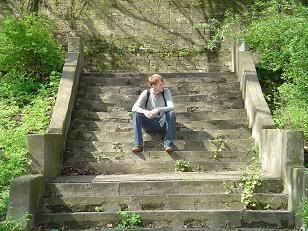While I did not plan it this way, today's post has turned into a little bit of a photo-essay of my walk around Kiev.
This was not the plan because I had actually intended to go to the archive where the Communist Party records are available. Unfortunately, they were closed for a regularly scheduled maintenance day. So instead I played tourist.
The archive is about two metro stops from the center of the city. The metro here is insanely cheap: a ride - represented by a little blue plastic token about the size of an American nickel - is 2 hr., or about 25 cents. By comparison, in Moscow, a ride costs anywhere from 3-5 times that, depending on how many you buy at once. All this is to say that money was not the reason I decided to walk the distance back to the center. Along the way, I passed rows of Soviet-era housing blocs that sprung up in the post-World War II period.

After about 20-25 minutes' walk, I arrived in the center of the city, at Bessarab'ski market, the city's central food market. Since I was planning a good bit more walking, I didn't buy anything, but I did check it out and do plan to go back to pick up some fresh fruits and vegetables, not to mention some Ukrainian sausages.
After that, I walked up the Boulevard Shevchenko, where this picture was taken. While not a whole lot survived the war, the streets that did are quite pleasant. It's hard to beat a walk along a tree-lined boulevard on a brisk winter day.
 On the recommendation of my friend with whom I'm staying, I stopped after a couple of blocks to check out "The Museum of the Ukrainian People's Republic." It's only one room, but it's surprisingly thorough in covering the events between February 1917 and 1921 in Ukraine and Kyiv. During these years there was an attempt to establish an independent Ukrainian state. The Rada, its governing body during the early stages, sat in this building, which today is houses a number of teachers' organizations, as well as this one-room museum. I would need innumerable blog posts to explain the complexity of the period, but to suffice it to say it was a violent, multi-sided, and messy affair which the Bolsheviks won only with great difficulty.
On the recommendation of my friend with whom I'm staying, I stopped after a couple of blocks to check out "The Museum of the Ukrainian People's Republic." It's only one room, but it's surprisingly thorough in covering the events between February 1917 and 1921 in Ukraine and Kyiv. During these years there was an attempt to establish an independent Ukrainian state. The Rada, its governing body during the early stages, sat in this building, which today is houses a number of teachers' organizations, as well as this one-room museum. I would need innumerable blog posts to explain the complexity of the period, but to suffice it to say it was a violent, multi-sided, and messy affair which the Bolsheviks won only with great difficulty.
A little further up the street, Kyiv's opera house. Tonight's feature: Turandot.
Kyiv's history is a long one, reaching back before 1000 AD, when it was a major point on trade routes between northern lands and the Byzantine Empire to the south, as well as in contact with various cultures of the steppes to the east.
This is, of course, a problem, when those steppe peoples - like Batu Khan and his Mongols in 1240 - show up and burn the joint to the ground. One of the few structures to survive from that period - although it has been rebuilt and renovated along the way - is the Golden Gate. For those of you who remember my posts from Vladimir, this is the ur-Golden Gate that inspired that one.
These two pictures are of a central square, the last place I went on my walk today. If you remember footage of the Orange Revolution of 2004, this might look familiar, as the rallies that led to a rerun of the presidential election of that year took place in this square, Maidan Nezalezhnosti, or Independence Square. In the above picture, there are two of the postwar buildings that line the western side of the square (there are several more not pictured, of similar style) and a statue of the Archangel Michael, the city's protector. In the lower picture, the other side of the square. For reference, the apartment where I am staying is just beyond the large building in the center, which is a hotel.





No comments:
Post a Comment